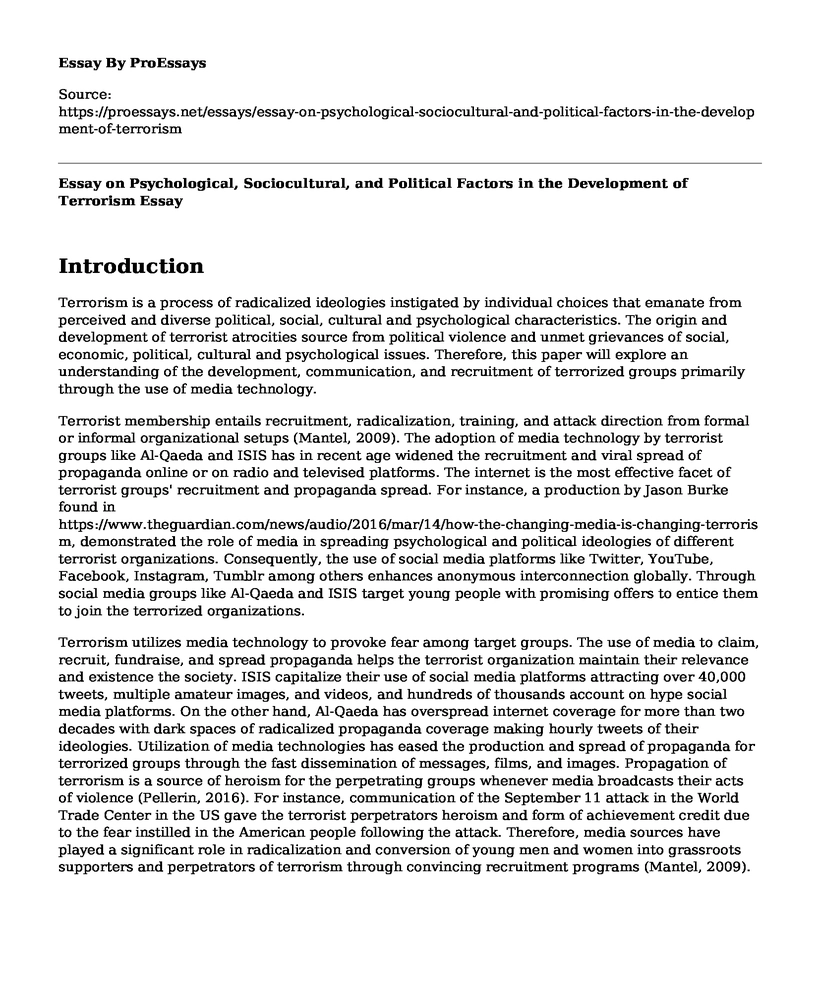Introduction
Terrorism is a process of radicalized ideologies instigated by individual choices that emanate from perceived and diverse political, social, cultural and psychological characteristics. The origin and development of terrorist atrocities source from political violence and unmet grievances of social, economic, political, cultural and psychological issues. Therefore, this paper will explore an understanding of the development, communication, and recruitment of terrorized groups primarily through the use of media technology.
Terrorist membership entails recruitment, radicalization, training, and attack direction from formal or informal organizational setups (Mantel, 2009). The adoption of media technology by terrorist groups like Al-Qaeda and ISIS has in recent age widened the recruitment and viral spread of propaganda online or on radio and televised platforms. The internet is the most effective facet of terrorist groups' recruitment and propaganda spread. For instance, a production by Jason Burke found in https://www.theguardian.com/news/audio/2016/mar/14/how-the-changing-media-is-changing-terrorism, demonstrated the role of media in spreading psychological and political ideologies of different terrorist organizations. Consequently, the use of social media platforms like Twitter, YouTube, Facebook, Instagram, Tumblr among others enhances anonymous interconnection globally. Through social media groups like Al-Qaeda and ISIS target young people with promising offers to entice them to join the terrorized organizations.
Terrorism utilizes media technology to provoke fear among target groups. The use of media to claim, recruit, fundraise, and spread propaganda helps the terrorist organization maintain their relevance and existence the society. ISIS capitalize their use of social media platforms attracting over 40,000 tweets, multiple amateur images, and videos, and hundreds of thousands account on hype social media platforms. On the other hand, Al-Qaeda has overspread internet coverage for more than two decades with dark spaces of radicalized propaganda coverage making hourly tweets of their ideologies. Utilization of media technologies has eased the production and spread of propaganda for terrorized groups through the fast dissemination of messages, films, and images. Propagation of terrorism is a source of heroism for the perpetrating groups whenever media broadcasts their acts of violence (Pellerin, 2016). For instance, communication of the September 11 attack in the World Trade Center in the US gave the terrorist perpetrators heroism and form of achievement credit due to the fear instilled in the American people following the attack. Therefore, media sources have played a significant role in radicalization and conversion of young men and women into grassroots supporters and perpetrators of terrorism through convincing recruitment programs (Mantel, 2009).
References
Mantel, B. (2009) Terrorism and the Internet: Understanding Terrorism. Should Web Sites That Promote Terrorism Be Shut Down? CQ Researcher, 129 - 153.
Pellerin, C. (2016). Communicating Terror: An Analysis of ISIS Communication Strategy, Science Po. Retrieved from http://www.sciencespo.fr/psia/sites/sciencespo.fr.psia/files/ PELLERIN_Clara_KSP_Paper_Award.pdf
Cite this page
Essay on Psychological, Sociocultural, and Political Factors in the Development of Terrorism. (2022, Apr 12). Retrieved from https://proessays.net/essays/essay-on-psychological-sociocultural-and-political-factors-in-the-development-of-terrorism
If you are the original author of this essay and no longer wish to have it published on the ProEssays website, please click below to request its removal:
- Challenges Female Executives Face Essay Example
- Animal Zoos Argumentative Essay Example
- Essay on Racial Profiling as a Contemporary Social Problem in the United States
- Essay Sample on Gender Inequality in Louisiana: The Impact on Women's Health
- Essay Sample on Substance Abuse: A Growing Problem Affecting Young People
- Essay Example on Childhood Obesity in Alabama: A Community Health Assessment
- Essay Sample on Informed Consent: A Challenge for Decisionally Impaired Individuals







